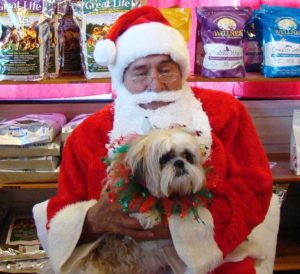
Happy holidays to all of my wonderful readers.
• The ASPCA has assisted federal authorities with the removal and sheltering of approximately 156 dogs from a dog fighting operation in eastern North Carolina. The victims have been transported to a temporary shelter for immediate care. Cruelty to animals is just not acceptable. People that do this should go to prison for a very very long time.
• by Victoria Usher
A French mastiff by the name of Hooch was recently named Hero Dog of the Year and given an award by the 2016 American Humane Organization in a Beverly Hills ceremony. The was the sixth year of the awards and the finalists were being celebrated for all types of commendable things. Some dogs comfort those who are sick, some help police officers, and others even rescue those who are lost.
Hooch was nominated for being a strong survivor. Hooch was rescued three years ago by Zach Skow, founder and operator of Marley’s Mutts Dog Rescue in Tehachapi, California. Zach Skow said that the rescuing goes both ways. When Hooch was found, he had been emaciated, had a broken tail bone, and had his ears badly cropped. These things were clear signs of abuse. With the help of Skow, Hooch slowly regained his health. Even after everything he’s been through Hooch is still kind to people and trusts them, that’s what makes him Hero Dog of the Year.

• Three to four days a week, Philadelphia veterinarian Clint Kuban drops off his 3-year-old German shepherd, Tsunami, at the Penn Vet Working Dog Center for her eight-hour shift.
But the pooch isn’t just participating in agility, obedience and search training — she’s also on the front lines of cancer research.
Kuban is one of six fourth-year students at the University of Pennsylvania School of Veterinary Medicine. Tsunami has worked on the center’s ovarian-cancer-detection research project since it launched in 2013 to study whether odors emanating from ovarian tissue can provide a reliable method for early detection.
Using a “scent wheel” — a circular device with 12 ports used to introduce multiple sources of scent researchers can isolate the exact volatile organic compounds that the dogs can smell. In these 10- to 15-minute smelling sessions, Tsunami’s nose is more than 90 percent accurate in identifying malignancies.
“There is no machine that is as powerful and as specific as what our dogs can do,” says Kuban. “Canines smell up to 1,000 times more accurately than humans, and they have up to 300 million olfactory receptors as opposed to out 6 million.”
Tsunami and the two other dogs in the program — a 3-year-old springer spaniel and a 5-year-old yellow Labrador retriever — were selected for their precise hunt drive and specifically trained to identify the cancerous compounds, first in tumor samples and then just plasma samples, explains Dr. Cindy Otto, director of the Penn Vet Working Dog Center.
The canine study is hoping to increase survival odds through early detection. Ovarian cancer is the fifth-leading cause of cancer deaths among women in the US, according to the CDC. More than 80 percent of patients are diagnosed at a late stage, according to the Penn Vet Working Dog Center.
“By isolating the chemicals of cancer that the dogs can smell, the team hopes to one day create an electronic sensor that can detect cancerous tissues early,” Kuban explains. “The end goal is actually not to have dogs in doctor’s offices doing diagnoses.”
